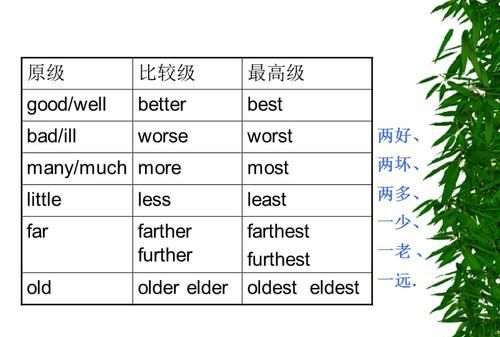本文目录
英语中形容词的用法及位置
下面是我整理的一些关于英语中形容词用法 总结 ,希望对大家的 英语学习 有所帮助。
英语中形容词用法详解
1.形容词的作用与位置
l)用作定语,修饰名词.一般放在所修饰的名词之前,如果两个以上的形容词修饰一个名词时,与被修饰名词关系密切的形容词靠近名词;如果几个形容词的重要性差不多,音节少的形容词在前,音节多的放在后.例如:
a powerful socialist country
an interesting English film
a small but beautiful room(音节多的在后)
2)用作定语,修饰由不定代词one,no,any,some和 every构成的复合词,如anything, something时,通常放在所修饰的词后面,例初:
I have something interesting to tell you.
3) 用作表语,与系动词 be,grow,get,become,feel,appear,prove,seem,look,keep, smell,taste,sound,turn,remain等连用,例如:
The desk is clean.
The weather is getting warmer and warmer.
4)用作宾语补足语.例如:
The news made every one happy.
I think the text very interesting.
5)与定冠词一起表示某一类人或物,在句中可作主语,宾语.例如:
The rich and the poor live very different lives.(主语)
6)作状语,表示伴随状况、原因、结果等。例如:
He went to bed, could and hungry.
Afraid of troubles,he would not accept the duty.
注意:①某些表示健康状况的形容词只能作表语,不能用作定语,如 well,ill, faint等.当 ill作定语修饰名词时,其含义相当干 bad;但sick一词既可作表语, 又可作定语,表示“生病”.例如:
The woman is sick.. the sick woman.
② 某些以 a-开首的形容词例如:afraid,alike,alone,asleep,awake等只能作表语,不能作定语。
③某些以 -ly 结尾的词是形容词而不是副词. 例如:friendly,lively,lovely,lonely,likely,deadly,silly,orderly等.
④plenty of,a lot of一般不用于疑问句和否定句中
2.复合形容词的构成
1)形容词词干十名词十 ed
kind- hearted(好心的)
2)形容词词干十形容词词干
red- hot(炽热的),dark- blue(深蓝的)
3)形容词词干十现在分词词干
tried- looking(面带倦容的) ordinary- looking(长相一般的)
4)副词词干十现在分词词干
hard- working(勤劳的) quick- firing(速射的)
5)副词词干十过去分词词干
hard- won(得来不易的) newly- made(新建的)
6)名词词干十形容词词干
life- long(终生的) world- famous(世界闻名的)
7)名词词干十现在分词词干
peace- loving( 爱好 和平的) mouth- watering(令人垂涎的)
8)名词词干十过去分词词干
snow- covered(白雪复盖的) hand- made(手工的)
9)数词词干+名词十 ed
four- storeyed(四层的) three- legged(三条腿的)
10)数词词干十名词词干
ten- year(十年的) two- man(二人的)

英语中名词动词形容词的用法
一、动词的用法:
(一)动词的种类
动词是表示动作或状态的词,按其词义和在句子中的作用可分为行为动词,连系动词,助动词和情态动词。
1.行为动词
行为动词可分为及物动词 (vt)和不及物动词(vi),及物动词表示动作或状态,有完整的词义,能单独作谓语,后跟宾语;不及物动词表示动作或状态,有完整的词义,能单独作谓语,但后面不能直接跟宾语,如要带宾语则与介词或副词构成短语。
如:
More and more people study English.(vt)
The students are listening to the teacher carefully.(vi)
2.连系动词
连系动词本身有一定的词义,但不能独立作谓语,必须与表语一起构成谓语。常用的连系动词有 be, get, turn, become, look, feel, grow, seem, sound, taste, smell等。
如:
Our country is becoming stronger and stronger.
It feels damp.
3.助动词
助动词本身无词义,不能单独作谓语,只能和主要动词一起构成谓语动词,表示否定,疑问及动词的时态、语态、人称和数等语法特征,助动词有 be,do,have,shall,will等。
如:
How do you usually come to school?
The children are playing yo-yo now.
4.情态动词
情态动词本身有一定的意义,但不能独立作谓语,只能和主要动词原形一起构成谓语,表示说话人的语气和情态。情态动词没有人称和数的变化。情态动词有 can (could),may(might),must, need, ought to, dare等。
如:
Can I help you?
- Must we go now? –No, you needn't .
a. can与be able to的用法有所区别。can只用于一般现在时和过去时,指本身有能力的“能”;be able to用于各种时态均可,指须经过努力而“能”。
b. must与have/has to的用法。must表示说话人主观认为“必须”,只用于一般现在时和一般将来时;have/has to表示客观需要,意为“不得不”,它可用于各种时态。
c.need和dare既可作情态动词也可作行为动词。
(二)动词不定式
动词不定式 to do没有人称和数的变化,在句中不能独立作谓语,但可以和助动词或情态动词构成谓语,又可以在句子中作宾语、宾语补足语、状语、定语、主语、表语等。但它毕竟是动词,因此,具有动词的许多特点,如它可以有自己的宾语或状语构成不定式短语。
1.作主语。 如:
To learn English is very important.
但实际上不定式作主语常用 it来作形式主语,而将不定式移至谓语动词后作真正的主语。
如上句可表达为:
It's very important to learn English.
2.作表语。 如:
My idea is to ring him up at once.
3.作宾语。 如:
I have decided to go to Binjiang Primary School.
4.作宾语补足语。
a. ask, want, teach, tell, know, would like, allow等动词后面接动词不定式作宾语补足语。
如: The policemen asked him to get off the bus.
b. hear, see, look at, feel, watch, notice, listen to等动词后接不带to的动词不定式作宾语补足语。
如: We often see Miss Li clean the classroom.
c. let, make, have这些使役动词后接不带to的动词不定式作宾语补足语。但在被动语态中这些不带to的都须带上to。
如: In those days the bosses often made the workers work day and night.
d.动词help接动词不定式作宾语补足语,可带to也可不带to。
如: Can you help me (to) carry the heavy bag?
5.作定语。
a.与被修饰词有动宾关系。如:I have something important to tell you.但如果不定式动词为不及物动词,后面的介词千万不要省略。
如: Maybe they have three rooms to live in.
b.与被修饰词有主谓关系。
如: Mr Liang is always the first to come and the last to leave.
c.与被修饰之间只有修饰关系。
如: I have no time to play cards.
6.作状语,表示目的、原因、方法、方向、结果等。
如: I'll go to meet my friend at the railway station.
7.不定式复合结构“for sb. to do sth” 作主语时,常用“It is +adj+ for
of sb. to do sth”的句式。形容词good, bad, polite, unkind, kind, ice, clever,
right, wrong, careful等用“It is +adj +of sb. to do sth.”
其他形容词用 for。
如:
It's dangerous for you to ride so fast.
It's very kind of you to help me.
8.动词不定式与疑问句who, what, which, when, how, where, whether等连用。
如: I don't know when to start.
He didn't tell me where to go.
但上面结构相当于一个从句,故上述句子也可表达为:
I don't know when we'll start.
He didn't tell me where he would go.
注意:
a.有些动词或动词短语不能带不定式,只能接动词的-ing形式。
如: enjoy, finish, keep, mind, miss(错过),be busy, go on, keep on, be worth, practise等。
如: The peasants are busy picking apples.
Would you mind my opening the door?
b.有些动词后可接不定式,也可接动词的-ing形式,但意思不同。
如: Lu Jian forgot to post the letter.(该寄但还没做)
Lu Jian forgot posting the letter.(已经寄过信了)
They stopped to sing a song.(停止在做的工作而去做另一件工作)
They stopped singing.(停止正在做的工作)
二、形容词的用法:形容词是指用来修饰、说明名词或不定代词,表示人或物的性质、特征和状态。一般放在它所修饰的名词前作定语,也可独立作表语或宾语补足语等。
i. 作定语:
This is an interesting story. Kitty is a clever cat.
ii. 作表语:
Yao Ming is very tall. Our classroom is big and bright.
iii. 作宾语补足语:
Don't make your hands dirty. We're trying to make our school beautiful.
注意:
a. 有些形容词只能作表语。如:alone, afraid, asleep等。
如: That old man feels alone because his children are out. I'm afraid he can't come.
b. 形容词与不定代词something, anything, nothing, everything等连用时,要放在这些词后面。
如: There is something wrong with my DVD machine. It's nothing serious.
c. 某些形容词可以和定冠词连用,表示一类人或事物,其作用相当于一个名词。
如: the young(年轻人),the poor(穷人), the rich(富人)
d. 如果有两个以上的形容词修饰同一个名词时,其前后排列顺序一般如下:
限定词(a/the, this/some/her……)+数量词(先序数词后基数词)+观点+大小+形状+新旧+颜色+产地+材料+名词。
如:a big old German computer

英语形容词后缀的分类及用法
1.用于名词前作定语
Li Mei is a beautiful city girl. The new student comes from Japan..
2.在系动词后作表语
My father's car is very expensive. The English story is very interesting.
常见的后跟形容词作表语的动词:
①become, come, fall, get, go, grow, make, turn(表示"变成某种状态")
②continue, hold, keep, lie, remain, stay(表示"保持某种状态")
③appear, feel, look, smell, sound, taste, know(表示"感觉")
例如:
He turned red when he heard the news.
It's going to stay cold for some time. The beer tastes very delicious.
3.用作宾语补足语
Don't keep the door open. His success made him happy.
4."the+形容词",表示一类人或事物,相当于名词,用作主语及宾语
The old often think of old things. The new always take the place of the old.
5.有时也可用作状语或补语
Please speak loud and clear. These soldiers spent three days in the cold weather, cold and hungry.
6.少数形容词只能作表语,不能作定语.
这些形容词包括 ill,asleep,awake,alone,alive,well,worth,glad,unable,afraid等.例如:
Don't be afraid.
7.两个以上的形容词修饰同一个名词时的排列顺序
限定词→一般描绘性形容词→表示大小,长短,高低的形容词→表示形状的形容词→表示年龄,新旧的形容词→表示色彩的形容词→表示国籍,地区,出处的形容词→表示物质,材料的形容词→表示用途,类别的形容词→名词中心词.
an exciting international football match一场令人激动的国际足球赛
a new red sports shirt一件新的红色运动衫
a light black plastic umbrella一把轻的黑塑料伞
a small old brown wooden house 一座小的旧的棕色的木头房子

英语冠词的用法总结
英语形容词的用法:1.用作定语:This is a very interesting book.这是一本很有趣的书。2.用作表语:This book is very interesting.这本书很有趣等。
形容词的用法
1.用作定语:This is a very interesting book.这是一本很有趣的书。
2.用作表语:This book is very interesting.这本书很有趣。
3.用作补语:We found this book very interesting.我们发现这本书很有趣。
4.“the+形容词”表示一类人:We should try to help the poor.我们应该设法帮助穷人。
5.“the+国家形容词”表示民族的整体:The Chinese are hardworking and friendly.中国人勤劳友好。
6.用作状语:Finally, he arrived here, cold and hungry.最终,他到这儿时又冷又饿。
7.表语形容词:只能作表语,不能位于名词前作定语。例如以下形容词(尤其是以a-开头居多):
√ He is (gets/ feels) ill.
× He is an ill man.
8.定语形容词:只作定语,不能用于系动词后作表语。例如:
√ A little boy
× The boy is little.
形容词的判断方法
判断一个词是不是形容词,可以从其结构特点和句法特点两方面来确定。
结构特点
以-able,-al,-ful,-ic,-ish,-less,-ous,-y等后缀结尾的词,一般是形容词。如:changeable(多变的),medical(医学上的),careful(仔细的),atomic(原子的),foolish(愚蠢的),careless(粗心的),delicious(美味的),healthy(健康的),rainy(多雨的)等。
句法特点
大多数形容词都可以作定语;在be,look,seem等词之后作表语;可用very来修饰,有比较级和最高级形式。其中,在句中作定语或作表语是形容词最主要的特点。

以上就是关于形容词的用法英语 ,英语中形容词的用法及位置的全部内容,以及形容词的用法英语 的相关内容,希望能够帮到您。

